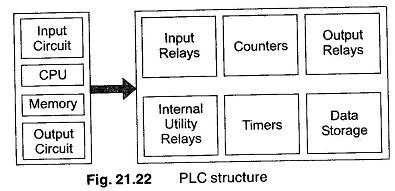PLC Structure:
The PLC Structure mainly consists of a CPU, memory areas, and appropriate circuits to receive input/output data as shown in Fig. 21.22. A PLC can be considered as a box full of hundreds of thousands of separate relays, counters, timers and data storage locations. (These counters, timers, etc. really do not exists physically but rather they are simulated and can be considered software counters, timers, etc). These internal relays are simulated through bit locations in registers.
The PLC structure consists of the following
- Input Relays: (Contacts) These are connected to the outside world. They physically exist and receive signals from switches, sensors, etc. Typically they are not relays but are transistors.
- Internal Utility Relay: (Contacts) These do not receive signals from the outside world nor do they physically exist. They are simulated relays and are what enables a PLC to eliminate external relays. There are also some special relays that are dedicated to performing only one task. Some are always ON while some are always OFF. Some are ON only once during Power-on and are typically used for initializing data that was stored.
- Counters: These again do not physically exist. They are simulated counters and they can be programmed to count pulses. Typically these counters can be up-count, down count or both. Since they are simulated they are limited in their counting speed. Some manufacturers also include high speed counters that are hardware based.
- Timers: These also do not physically exist. They come in many Varieties and increments. The most common type is an ON-delay type. Others include OFF-delay and both retentive and non-retentive types. Increments vary from 1 ms — ls.
- Output Relays: (Coils) These are connected to the outside world. They exist physically and send ON/OFF signals to solenoid, lamps, etc. They can be transistors, relays or triacs depending upon the type selected.
- Data Storage: Typically there are registers assigned simply to store data. They are usually used as temporary storage for math or data They can also be used to store data in case of a power failure. These registers ensure that there is no loss of contents owing to disconnection of power.
